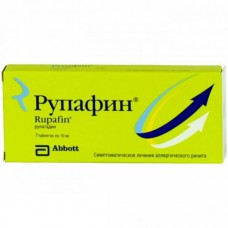Expiration date: 04/2026
Clinico-pharmacological group
(The blocker of histamine H1-receptors. Anti-inflammatory drug)
Release form, composition and packaging
Tablets are light orange-pink, round.
Auxiliary substances: starch pregelatinization - 10 mg cellulose, microcrystalline 15 mg, colorant iron oxide red (E172) - 25 mcg, dye iron oxide yellow (E172) - 75 mcg, lactose monohydrate - 61.1 mg, magnesium stearate - 1 mg.
7 PCs. - blisters (1) - packs of cardboard.
7 PCs. - blisters (2) - packs of cardboard.
10 PCs. - blisters (1) - packs of cardboard.
Pharmacological action
Rupatadine refers to the second generation antihistamines and is a long-acting and selective blocker of peripheral H1-histamine receptors. Some of its metabolites (desloratadine and 3-hydroxydesloratadine) retain an antihistaminic activity and may contribute to the overall effectiveness of the drug.
Rupatadine shows a high affinity to H1-histamine receptors. Research rupatadine in vitro in a high concentration, showed suppression of degranulation of mast cells caused by immunological and not immunological stimuli, inhibition of the chemotaxis of eosinophils and neutrophils, and release of cytokines (interleukin (IL)-5, IL-6, IL-8, GM-CSF (granulocyte-macrophage colony stimulating factor)), in particular TNF-? (tumor necrosis factor alpha) from mast cells and monocytes. Additionally, rupatadine caused a dose-dependent suppression of expression of adhesion molecules on neutrophils.
Due to the selectivity of rupatadine in respect of peripheral H1-histamine receptors it does not have a significant effect on the activity of the Central nervous system at doses of 10 or 20 mg/day.
Pharmacokinetics
Absorption and distribution
Rupatadine rapidly absorbed after ingestion, time to reach Cmax is approximately 0.75 h. the Average Cmax is 2.6 ng/ml after a single oral administration of 10 mg of rupatadine and 4.6 ng/ml after a single oral administration of 20 mg of rupatadine. The pharmacokinetics of rupatadine is linear for doses from 10 to 40 mg.
After administration of 10 mg 1 times/day for 7 days, the average Cmax is 3.8 ng/ml plasma Concentration decreases biexponentially curve, with average T1/2 of 5.9 h. the Ratio of rupatadine binding with plasma proteins is 98.5-99%. As rupatadine never been used on/in humans, data on its absolute biological availability.
Meal strengthens the total effect of rupatadine on the body (AUC increases by about 23%). Impact on one of its active metabolites and the primary inactive metabolite is almost identical (a decrease of approximately 5% and 3%, respectively). The time required to achieve Cmax of rupatadine lengthened to 1 h. Cmax in plasma was not changed by simultaneous ingestion with food. These differences had no clinical significance.
Metabolism and excretion
Rupatadine undergoes significant presystemic metabolism when administered. The unchanged active substance found in the urine and feces only in small quantities. This means that rupatadine almost completely metabolized. Studies of metabolism in vitro in human liver microsomes indicate that rupatadine is metabolized primarily by cytochrome P450 (CYP isoenzyme 3A4).
In the study of excretion in humans (40 mg of 14C-rupatadine) found that 34.6% of the drug excreted by the kidneys, and 60.9% - through the intestines within 7 days. The average T1/2 of 5.9 h.
Pharmacokinetics in special clinical cases
In a study in healthy volunteers when comparing the results obtained in young and elderly, AUC values and Smuggle of rupatadine was higher in older study participants. This is probably due to reduced hepatic metabolism when "first pass" through the liver in the elderly. These differences were noted only for rupatadine and not to its metabolites. The average value of T1/2 of rupatadine in elderly and young volunteers was 8.7 h and 5.9 h, respectively. Since the results for rupatadine and its metabolites were not clinically significant, it was concluded that in the appointment of older patients at a dose of 10 mg correction dose is not required.
Dosage
Inside, regardless of meals.
Adults and children over 12 years: the recommended dose is 10 mg (1 tab.) 1 time/day.
Overdose
The literature describes the cases of drug overdose. In the study on clinical safety rupatadine was well tolerated in a daily dose of 100 mg for 6 days.
Symptoms: the most common adverse reaction is drowsiness.
Treatment: in case of accidental ingestion of the drug in very high doses shown to cause vomiting in a patient with subsequent administration of activated charcoal. If this manipulation is impossible or ineffective, it is necessary to wash out the stomach with isotonic sodium chloride solution.
Drug interactions
Interaction with ketoconazole and erythromycin
The combined use of rupatadine at a dose of 20 mg and ketoconazole or erythromycin increases the systemic impact of rupatadine 10 times and the last 2-3 times. These combinations are not accompanied by changes in QT interval or increased frequency of adverse reactions in comparison with separate use of these drugs.
However, rupatadine should be used with caution in conjunction with these drug substances and other inhibitors of CYP3A4.
Interaction with grapefruit juice
Simultaneous reception of rupatadine and grapefruit juice 3.5 times increases the action of rupatadine. Do not drink grapefruit juice at the same time with the drug.
Interaction with ethanol
While the use of ethanol rupatadine at a dose of 10 mg does not cause more pronounced changes in cognitive, psychomotor activities, compared to receiving only ethanol. Rupatadine, adopted at a dose of 20 mg, enhances the changes induced by intake of ethanol.
Interaction with drugs, CNS depressants
We cannot exclude the possibility of interaction of rupatadine with other antihistamines and drugs, depressing the Central nervous system.
Interaction with statins
Due to the fact that some of the statins, also known as rupatadine, metabolized by CYP3A4 isoenzyme of cytochrome P450, we can not exclude the possibility of increasing the level of CPK in their joint application. For these reasons rupatadine should be carefully used in conjunction with statins.
Pregnancy and lactation
Drug Ruppin contraindicated during pregnancy and lactation.
Side effects
Most often in patients receiving rupatadine, it was reported such adverse reactions to the drug like drowsiness, headache and fatigue, manifested in 9.5%, 6.9% and 3.2% of patients, respectively. In most cases, drug withdrawal was not required.
Classification of adverse reactions according to frequency (number of incidences/number of patients): very often - more than 1/10 of the cases, often from 1/10 to 1/100 of the cases, rarely, from 1/100 to 1/1000 cases.
From the nervous system: often - drowsiness, headache,dizziness, fatigue, asthenia, rarely, decreased concentration, irritability.
The respiratory system: rare - nasal bleeding, dryness of the nasal mucosa, pharyngitis, cough, dry throat, pain in the throat and in the larynx, rhinitis.
From the digestive system: often - dry mouth, rarely - nausea, diarrhea, dyspepsia, vomiting, abdominal pain, constipation.
From the metabolic and nutritional: rarely - increased appetite.
The skin and subcutaneous tissue: often - rash.
From the side of musculoskeletal system: rarely - pain in the back, artralgia, myalgia.
From the body as a whole: infrequent - thirst, malaise, fever, increase of body weight.
Changes in laboratory parameters: infrequently - increase in ck, ALT, AST, indicators of liver function tests.
Terms and conditions storage
The drug should be stored in a dry, dark, inaccessible to children place at temperature not exceeding 25°C. shelf Life - 3 years.
Testimony
Symptomatic treatment in adults and adolescents over 12 years:
— allergic rhinitis,
— chronic idiopathic urticaria.
Contraindications
— renal failure,
— liver failure,
— pregnancy,
— lactation,
— children up to age 12 years (efficacy and safety not established),
— rare hereditary galactose intolerance, lactase deficiency or malabsorption of glucose-galactose
— hypersensitivity to the drug.
With caution should appoint patients with prolonged QT interval, uncorrected hypokalemia, resistant proaritmicski conditions such as clinically significant bradycardia, acute myocardial ischemia, older patients (65 and older), simultaneously with statins, along with grejpfrutovogo.
Special instructions
Effects on ability to drive vehicles and management mechanisms
In applying the drug in a dose of 10 mg had no effect on the ability to drive a car and other mechanisms. At the same time there are reports of drowsiness observed during treatment with Ruppina. In this regard, it is recommended to exercise caution while driving or doing other potentially hazardous activities, require high concentration and psychomotor speed reactions until individual response of the patient to rupatadine.
Use in impaired renal function
Contraindicated in renal failure
Use in hepatic impairment
Contraindicated in liver failure



